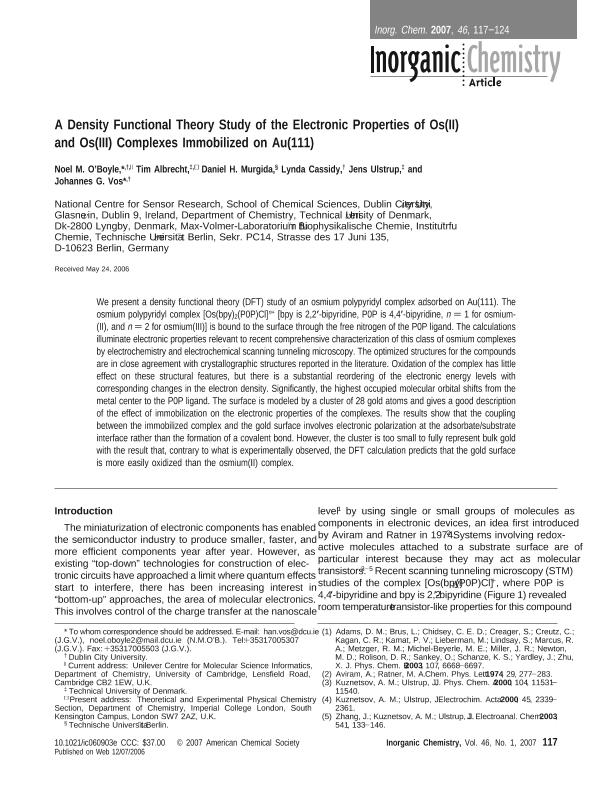Mostrar el registro sencillo del ítem
dc.contributor.author
O'Boyle, Noel M.
dc.contributor.author
Albrecht, Tim
dc.contributor.author
Murgida, Daniel Horacio

dc.contributor.author
Cassidy, Lynda
dc.contributor.author
Ulstrup, Jens
dc.contributor.author
Vos, Johannes G.
dc.date.available
2020-04-28T22:33:39Z
dc.date.issued
2007-01-08
dc.identifier.citation
O'Boyle, Noel M.; Albrecht, Tim; Murgida, Daniel Horacio; Cassidy, Lynda; Ulstrup, Jens; et al.; A density functional theory study of the electronic properties of Os(II) and Os(III) complexes immobilized on Au(111); American Chemical Society; Inorganic Chemistry; 46; 1; 8-1-2007; 117-124
dc.identifier.issn
0020-1669
dc.identifier.uri
http://hdl.handle.net/11336/103856
dc.description.abstract
We present a density functional theory (DFT) study of an osmium polypyridyl complex adsorbed on Au(111). The osmium polypyridyl complex [Os(bpy)2(P0P)Cl]n+ [bpy is 2,2'-bipyridine, P0P is 4,4'-bipyridine, n = 1 for osmium(II), and n = 2 for osmium(III)] is bound to the surface through the free nitrogen of the P0P ligand. The calculations illuminate electronic properties relevant to recent comprehensive characterization of this class of osmium complexes by electrochemistry and electrochemical scanning tunneling microscopy. The optimized structures for the compounds are in close agreement with crystallographic structures reported in the literature. Oxidation of the complex has little effect on these structural features, but there is a substantial reordering of the electronic energy levels with corresponding changes in the electron density. Significantly, the highest occupied molecular orbital shifts from the metal center to the P0P ligand. The surface is modeled by a cluster of 28 gold atoms and gives a good description of the effect of immobilization on the electronic properties of the complexes. The results show that the coupling between the immobilized complex and the gold surface involves electronic polarization at the adsorbate/substrate interface rather than the formation of a covalent bond. However, the cluster is too small to fully represent bulk gold with the result that, contrary to what is experimentally observed, the DFT calculation predicts that the gold surface is more easily oxidized than the osmium(II) complex.
dc.format
application/pdf
dc.language.iso
eng
dc.publisher
American Chemical Society

dc.rights
info:eu-repo/semantics/openAccess
dc.rights.uri
https://creativecommons.org/licenses/by-nc-sa/2.5/ar/
dc.subject
OSMIUM COMPLEXES
dc.subject
ELECTRON TRANSFER
dc.subject
RAMAN
dc.subject
DFT CALCULATIONS
dc.subject.classification
Físico-Química, Ciencia de los Polímeros, Electroquímica

dc.subject.classification
Ciencias Químicas

dc.subject.classification
CIENCIAS NATURALES Y EXACTAS

dc.title
A density functional theory study of the electronic properties of Os(II) and Os(III) complexes immobilized on Au(111)
dc.type
info:eu-repo/semantics/article
dc.type
info:ar-repo/semantics/artículo
dc.type
info:eu-repo/semantics/publishedVersion
dc.date.updated
2020-04-22T15:40:32Z
dc.journal.volume
46
dc.journal.number
1
dc.journal.pagination
117-124
dc.journal.pais
Estados Unidos

dc.description.fil
Fil: O'Boyle, Noel M.. Dublin City University; Irlanda
dc.description.fil
Fil: Albrecht, Tim. Technical University of Denmark; Dinamarca
dc.description.fil
Fil: Murgida, Daniel Horacio. Consejo Nacional de Investigaciones Científicas y Técnicas. Oficina de Coordinación Administrativa Ciudad Universitaria. Instituto de Química, Física de los Materiales, Medioambiente y Energía. Universidad de Buenos Aires. Facultad de Ciencias Exactas y Naturales. Instituto de Química, Física de los Materiales, Medioambiente y Energía; Argentina. Technische Universita¨t Berlin; Alemania
dc.description.fil
Fil: Cassidy, Lynda. Dublin City University; Irlanda
dc.description.fil
Fil: Ulstrup, Jens. Technical University of Denmark; Dinamarca
dc.description.fil
Fil: Vos, Johannes G.. Dublin City University; Irlanda
dc.journal.title
Inorganic Chemistry

dc.relation.alternativeid
info:eu-repo/semantics/altIdentifier/url/https://pubs.acs.org/doi/10.1021/ic060903e
dc.relation.alternativeid
info:eu-repo/semantics/altIdentifier/doi/http://dx.doi.org/10.1021/ic060903e
Archivos asociados
